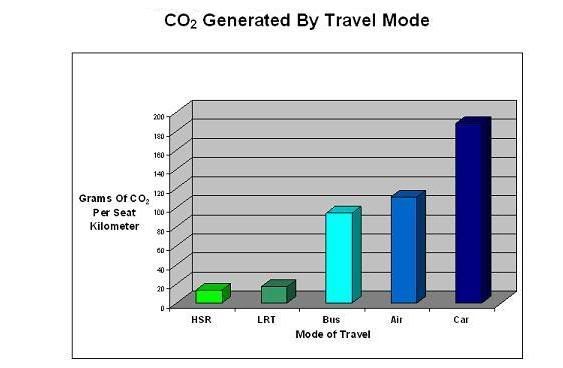It seemed appropriate to use Earth Day to remind ourselves of the environmental and climate benefits of the high speed rail project. While the finances of the project are getting the most discussion in the state's media, HSR is necessary if we are to have any hope of meeting the AB 32 carbon reduction goals and actually do something about global warming and pollution.
In brief, the key environmental benefits of California HSR:
-Reduce carbon dioxide emissions equivalent to removing 1.4 million cars from the road, and take the place of nearly 42 million annual city-to-city car trips (Final EIR p. 92)
-Reduce CO2 emissions by up to 17.6 billion pounds/year (Quentin Kopp op-ed)
-Reduce California’s oil consumption by up to 22 million barrels/year (same as above)
According to the Final EIR 63% of intercity trips over 150 miles in California are taken by car (scroll to page 12). This is a major factor in causing most of California to be out of compliance with state clean air goals. Given that HSR would be much faster than driving between California's major metro regions, and will likely be less costly as well by 2018, HSR would make a significant dent in those car trips and therefore in the pollution they spew.
And HSR provides a VAST carbon emissions savings over other forms of transportation:
(Image from Alberta High Speed Rail)
Some might ask about the electricity generation for the HSR project. The CHSRA is currently undertaking a study of how to power the system with zero greenhouse gas emissions. Given the potential for thermal solar in the Central Valley and wind power in some of the mountain passes and the Delta, a carbon neutral high speed rail system is entirely possible.
These facts are more than compelling. They demonstrate why high speed rail is an absolutely necessary part of California's solution to the great crisis of the 21st century - global warming and its effect on our environment. Although there are several other important reasons for HSR, on the environmental basis alone this project is something California cannot afford to reject.
Monday, April 21, 2008
HSR is Vital for a Green California
NOTE: We've moved! Visit us at the California High Speed Rail Blog.
Labels:
carbon emissions,
CHSRA,
climate,
environment,
pollution,
sustainability
Subscribe to:
Post Comments (Atom)

1 comment:
According to chapter 7.1.1 the CHSRA's final EIR/EIS, the rail option would consume 37% less energy during the construction phase than the modal alternative. However, note that the agency's absolute numbers given for both the modal and the HST alternatives appear to be off by several orders of magnitude, with no correction in the errata.
In operation, where the estimated increments in energy use are more credible, the advantage is asserted at 22%. Note that the electricity required to operate the HSR system could easily be 100% renewable, i.e. solar, wind, biogas and/or or geothermal.
Even in the rosiest scenario, only a fraction of cars could be powered using sustainable biofuels or renewable electricity by 2020.
For reference, the amount of energy expended in the construction of one lane-mile of road is usually equivalent to 6-24 months of operation. Adding lanes to existing congested freeways is probably at the lower end of that scale.
For a heavily used rail network such as the one proposed for California's HSR, the energy footprint of construction is probably also on the order of several months', not years', worth of operation.
Post a Comment